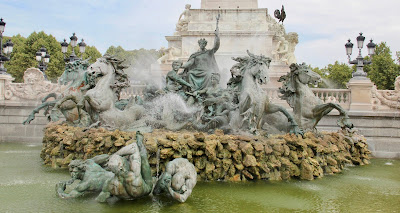We have discovered that there are magical places on this earth that no one tells you about. I have no idea why this is so but a small clutch of people seem to learn about these places and that is all. They are not made widely public. Not much is written, either. So when you accidently stumble across one of these special places, you, yourself, are conflicted, in two minds as to whether to say a word about it to anyone, potentially opening it up to too many visitors, or to stay silent about it, and just let it be. Let it be.
We drove to Coulon because it was on our list as one of the Most Beautiful Villages in France, in the Poitou-Charentes, but we stayed, and we stayed some three days which for us, is all we can usually spare in terms of time, because we simply could not bring ourselves to leave.
It is not the town: the town is pleasant enough and when we were there alive and throbbing. There was a marathon, called Maraisthon -- cleverly -- given that we were in the Marshes, and Marais means Marsh. Hundreds of folk entered the marathon, runners, bikers, women, men, children and oldies, occupying every spare field in this hollyhock strewn town with their camping cars and their tents. As well, there was music at either end of the village: at one end beside hay bales there was a boot scootin' country and western group of the mountain mama variety. At the other there was a rock band, playing Jumpin' Jack Flash with a French twist and a funny Mick Jagger accent. This is where you found us. We long-lunched on eels, frogs legs and entrecote, the local Marsh delicacies, while listening to music for much of our Sunday. So excellent.
It wasn't the town. And it wasn't the music. It was probably the monks. Mmm, the monks. Yes, I think the magic likely started with the monks. Way back in the mists of time this land was actually a bay. Tidal water flowed in and out of the bay, in and out, day after day. But, over centuries the bay started silting up. Like Maroochydore. Sand stayed too long when it should have gone out to sea. Silting up so much that the tide, finally, could not make the big leap over the formulating sand bar.
So, marsh grasses started to grow. Birds spread more seeds. Ash, willow and hazel trees sprouted. Soon the bay that once filled and emptied daily, was little more than a marsh. It was probably heading towards being a vast unhealthy fen, even a bog.
Invaders came and went, ugly villiens, some of them: cutting passageways through the marsh, taking ownership of this swampy land, weeping with willow. Then, the land was given to the Benedictines, then the Circestian monks, who built abbeys on marshy banks and dryer islands, and spent long days cutting waterways to boat their agricultural goods to market.
The Dutch were called in for advice given their expertise in water containment. They quickly designed bigger and better channels and many more dykes to be built and extended. And so the monks and the villagers laboured.
Today, there are some 600 kilometres of navigable channels throughout the Marais. So many that it is a virtual maze of acquatic channels. It is called Venice Verte. Green Venice. And, as in Venice, you can get lost in any part of it and never be found again. As easy as turning left or right.
Yet it is magic, a place of myth and legend and is utterly special. Deep beneath the channels is a rich peaty earth oozing methane. You can stir the earth through the water with a paddle and it rises to the surface leaking bubbles that can be set alight in a flare of red flames.
Children learn that a big red hand, the colour of flame, will drag them deep into the marsh water if they dare to get too close. And forever they will be lost. Pigouille pole batai gently through the evergreen canals dripping with willows. The water surface floats with a green sheen of duckweed. Gnarled and twisted roots bind the earth and strengthen the walls of the channels.
Small fields are bordered with poplars and each poplar drinks 200 litres of water a day doing its bit to keep the water at bay. Closer to the sea, saline meadows, called mizottes, are often immersed by water at high tide. They are filled with marsh and migratory birds, and birders follow their calls. Many motorhomers are bird watchers. All around are towns oozing with character, because, it is said, a fairy named Melusine, flew over this land, and so favoured it, that in just one night, with a mere dainty handful of pebbles and a single droplet of water, erected beautiful buildings, divine churches with exquisite stained glass windows, and villages to charm you at the heart. Sufficient to make your soul sing. So, let it be.
oooOOOooo
 |
| Boatmen quietly pole the waters |
 |
| Relic from the days of the monks |
 |
| Oozing flammable methane |
 |
| Waterlillies everywhere |
 |
| Another monkish stained glass relic |






















































